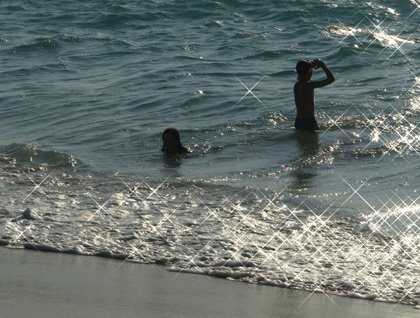The approach to Punta Pitt on the north-easternmost corner of San Cristobal Island, is in my mind one of the most dramatic scenes in Galapagos. The rising sun leaves the gullies in deep shadow until well into the morning, highlighting the ridges eroded over eons into a landscape of abstract art, forms and lines.
The trail to the upper plateau is not easy, requiring a scramble up a steep ravine for 320 feet. Once on top, the wind catches your hair and dries the sweat. Endemic lava lizards and mockingbirds were spotted periodically throughout the walk. This island has been isolated for several million years, in the southeast region of the archipelago. The prevailing winds come from the northeast or southeast, and definitely one-way. Anything that managed to arrive to this island from the mainland – and establish itself – was from thereon isolated for generations. Mutations, founder effect, and natural selection have created several species unique to this one piece of land, the lava lizard and mockingbird being among the most famous.
Our aim was to find red-footed boobies nesting on the outer bluff. Their rough courtship call could be heard through the wind before we finally reached the edge and saw them, perched either in the middle of dry trees and bushes, or on Nolana galapagoensis, an endemic shrub whose closest ancestor can only be found far south in Chile. To our delight, blue-footed boobies were also courting on top of the bluff, smack in the middle of the trail! Punta Pitt, which has been chosen by the National Park as a visitor trail, is one of the few areas where all three booby species in Galapagos can be found nesting in close proximity: blue-foot, red-foot and Nazca.
Back at the star-spangled beach, alight with sparks from reflective feldspars, many of us cooled off in the inviting ocean. Even a bit of snorkeling was to be had, since we had unusually excellent visibility this morning. We even put out our glass-bottom boat for a few outings because the ocean conditions were so favorable; surgeonfish, snappers, grunts, butterflyfish, wrasses, and even a couple stingrays were spotted!
The afternoon allowed us one last, grand, hurrah on one of the most beautiful beaches of San Cristobal Island: Cerro Brujo, or “wizard hill”. Here, one is free to wander alone the width and length of the white sand beach, all the way to the far end. Last chance for that endemic San Cristobal mockingbird; last chance for the endemic San Cristobal lava lizard! Big breakers provided some opportunities for body surfing, and sleeping sea lions ignored the photographers, yet were the focus of artistic framing and deep thoughts about the sanctity of all life forms.







